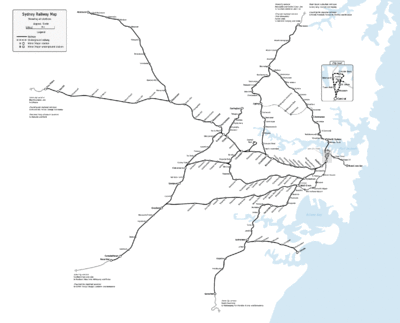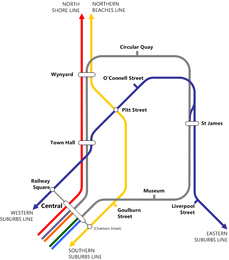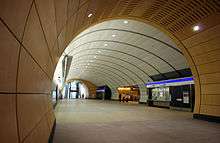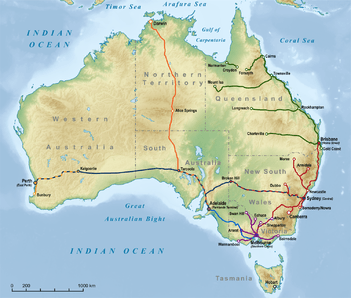Railways in Sydney

Sydney, the largest city in Australia, has an extensive network of passenger and freight railways. The passenger network is a hybrid metro-suburban railway with a central underground core running at metro style frequencies, which branches out into a suburban commuter type network. The system also carries freight, and there is a separate network of freight lines, some of which are disused.
The network has more in common with rapid transit systems than it does with North American and European commuter networks. This is illustrated by the everyday service, 20 hours a day operation, 15 minute or better frequencies on most of the network, large underground sections, a ridership comparable and even larger than most North American rapid transit systems and relatively small distances between stations.
Passenger service


Passenger service is operated in Sydney by Sydney Trains (launched 1 July 2013). Trains operate for 20 hours a day, and over 1 million weekday passenger journeys are made on 2365 daily services over 2080 km of track and through 306 stations (including interurban lines).[1] Suburban services operates along the portions of the main lines from Sydney to the north, west, south and south-west, and also along several dedicated suburban lines. All of these lines are electrified at overhead 1500 V DC, starting in 1926.
Most suburban services operate through central Sydney via the underground City Circle (a horseshoe-shaped line), the Eastern Suburbs underground line, or over the Harbour Bridge. There are long term plans for a new underground line passing beneath Pitt Street to a new harbour crossing (known as MetroPitt), and a long-standing concept for a new underground line that will pass down the western side of the central business district (known as MetroWest). A similar rail line called "Sydney Metro City" is currently in the planning stages with construction expected from 2017-2024
Timetables are published for all lines, and most lines run on headways of 15 minutes in peak periods, half-hourly off-peak and weekends. Headways are closer over shared routes. Although frequencies match metro style operation in the city core, few Sydneysiders use the underground network as a metro, most journeys being commuter trips from suburbs into the central city area. An exception to this is the Eastern Suburbs line which serves the high density inner eastern suburbs and opened in 1979.
Rolling stock
All suburban passenger trains in Sydney are double-deck electric multiple units. Upon electrification in the 1920s Sydney operated single-deck multiple units but these were progressively withdrawn from the 1960s until their final demise in 1993. Single-deck cars will be reintroduced to Sydney with the completion of the Sydney Metro Northwest.
Depots
Electric cars are maintained at depots at Hornsby in the northern suburbs, Mortdale in the southern suburbs, and Flemington in the western suburbs. A depot at Punchbowl in the southwest closed in 1994 and has since been demolished. These four depots were all built and opened with the opening of electrified services in the 1920s.
Heavy maintenance of passenger cars was carried out at the Electric Carriage Workshops, Chullora and Suburban Car Workshops, Redfern. Heavy maintenance is now contracted out to Maintrain, a private company with workshops at Clyde. All M (known as "Millennium") and H (known as "Oscar", for Outer Suburban CAR) Sets are maintained at Eveleigh Depot.
Freight services
Freight services operate over most of the suburban railway lines in Sydney, however due to the high frequency of passenger services and the lack of freight only tracks, there is a curfew on freight movements during peak hours.[2]
The major interstate freight routes are the Main Southern and Main North lines, with the Illawarra and Main Western lines serving lineside industries and as alternate interstate routes. In the inner city area the Metropolitan Goods Lines connects major freight terminals to the main passenger lines and the Southern Sydney Freight Line which runs parallel to the Main South line from the western end of the Metropolitan Goods Lines to a point beyond the end of suburban services.[3] As of 2013, construction of the Northern Sydney Freight Corridor is under way. This is a series of projects along the Main Northern line between Sydney and Newcastle aimed at increasing the number of freight trains operating along the route.
The main traffic is containerised freight. The main intermodal terminal are at Camellia, Leightonfield, Yennora and Minto.[4] Interstate train to Sydney terminals are up to 1500 metres long, while short-haul container trains from the terminals to the Port Botany seaport are around 600 metres long.[2] Coal services to Port Kembla are another major traffic. Freight operators include Pacific National, QRNational, Independent Rail, Australian Railroad Group, Southern & Silverton Rail and Patrick Port Logistics.[5]
History


The first railway in Sydney was opened in 1855 between Sydney and Granville, now a suburb of Sydney but then a major agricultural centre. The railway formed the basis of the New South Wales Government Railways. Passenger and freight services were operated from the beginning.[6] By 1880, there was half hourly service to Homebush.
In 1884, the railway opened from Strathfield to Hornsby. The North Shore line opened in 1893 to a harbour side station at Milson's Point, and was originally built because parliament thought it would be a shorter route for country produce from the north to Sydney Harbour (a role it has never fulfilled). Sydney's first deliberately suburban railway was a line to Belmore which opened in 1896 and was soon extended to Bankstown.
Sydney's suburban passenger service was severely hampered by the inconvenient location of its city terminus, at a site south of Devonshire Street. Most of Sydney's population was well served by trams, and the suburban railways had a relatively small initial role to play. This was to change in the 1920s.
The railway system as it exists today is really the result of the vision and foresight of John Bradfield, one of Australia's most respected and famous civil engineers. He was involved in the design and construction of Sydney underground railways in the 1920s and 1930s, but he is more famous for the associated design and construction of the Sydney Harbour Bridge.[7]
Electrification

New South Wales uses an overhead electrification system at 1,500 volts direct current.[8] Whilst inferior to and more expensive than modern single phase alternating current equipment, it was in vogue during the 1920s, having been used in Melbourne since 1919 and is generally sufficient for the operation of electric multiple unit trains. However, the introduction of powerful electric locomotives in the 1950s, followed by the Millennium train in 2002, revealed drawbacks in this antiquated system of electrification. As the voltage is relatively low, high currents are required to supply a given amount of power, which necessitates the use of very heavy duty cabling and substation equipment. Until the retirement of electric locomotives from freight service in the 1990s, it was often necessary to observe a "power margin" to ensure that substations were not overloaded. This situation was similar to that which applied to The Milwaukee Road's 3,000 VDC electrification. Plans to electrify the Hunter Valley at 25 kV alternating current were abandoned in the 1990s.
Electrification came to Sydney's suburbs on 9 December 1926 with the first suburban electric service running between Central station and Oatley on the Illawarra line.[9] In the same year, the first underground railway was constructed north from Central station to St James in Sydney's central business district. Electric trains that had previously terminated at Central station continued north, diving underground at the Goulburn Street tunnel portal, stopping at Museum station and then terminating at St James.[10] Other lines were soon electrified. Also, in conjunction with the construction of the Sydney Harbour Bridge which opened in 1932, an additional four-track underground line was constructed from Central station to Town Hall and Wynyard. Two of the tracks continued over the Harbour Bridge connecting to the North Shore line.
It was only in 1956 that the two tracks terminating at Wynyard were linked to the line terminating at St James via the Circular Quay viaduct. This new arrangement, dubbed the City Circle, allowed services to make a continuous run through the city and return to the suburbs without having to terminate.
Electrification timeline
- 1926 – Illawarra line to Royal National Park.
- 1926 – Bankstown line.
- 1927 – North Shore line.
- 1929 – Western line to Parramatta.
- 1929 – Northern line (Strathfield to Hornsby).
- 1929 – South line to Liverpool.
- 1936 – Carlingford line from Clyde to Rosehill.
- 1955 – Parramatta to Penrith.
- 1957 – Penrith to Lithgow.
- 1959 – Rosehill to Carlingford.
- 1959 – Hornsby to Cowan.
- 1960 – Cowan to Gosford.
- 1968 – Liverpool to Campbelltown
- 1975 – Blacktown to Riverstone.
- 1980 – Loftus to Waterfall.
- 1982 – Gosford to Wyong.
- 1984 – Wyong to Newcastle.
- 1985 – Waterfall to Port Kembla.
- 1985 – Macarthur station opened.
- 1991 – Riverstone to Richmond.
- 1996 – Coniston to Dapto.
- 2002 – Dapto to Kiama.[11]
- 2013 – Lithgow to Bathurst.
- future – Campbelltown to Moss Vale.
New electrified lines were built:
- 1926 – line from Central to St James station and Museum opened.
- 1931 – line opened to East Hills.
- 1932 – line from Central to Town Hall, Wynyard, the Sydney Harbour Bridge, Milsons Point station and North Sydney station opened.
- 1939 – Line to Cronulla built and connected with the Illawarra Line at Sutherland.
- 1956 – Circular Quay station opened completing the City Circle.
- 1979 – Eastern Suburbs railway completed to Bondi Junction
- 1987 – East Hills – Glenfield line opened.
- 1996 – Y-link built between Harris Park and Merrylands allowing the introduction of Cumberland line services from Campbelltown to Blacktown
- 1998 – line from Flemington and Lidcombe to Olympic Park.
- 2000 – line to Sydney Airport and Wolli Creek built as a public-private partnership by the Airport Link Company.
- 2009 – Epping to Chatswood railway line opened.
- 2015 – South West Rail Link opened.
Organisation
The rail network in the metropolitan area of Sydney is owned, maintained and operated by RailCorp, a NSW State Government owned corporation. Third party access to Railcorp's tracks by other freight operators is allowed under an open-access arrangement. Track outside the Sydney metropolitan area is operated and maintained by the Australian Rail Track Corporation. RailCorp operates passenger trains under the Sydney Trains brand, and long distance trains run through Sydney under the NSW TrainLink brand.
RailCorp was formed on 1 January 2004 by the merger of the State Rail Authority (SRA) and the metropolitan functions of the Rail Infrastructure Corporation. Until 1972, railways in NSW were operated by the New South Wales Government Railways until this department was replaced by the Public Transport Commission (PTC), which was also responsible for bus and ferry services. In 1980 the PTC was broken up into the State Rail Authority, responsible for rail services, and the Urban Transit Authority (UTA), responsible for bus and ferry services. The UTA later became the State Transit Authority.
In 2001, the State Rail Authority had its 'above track' operations separated from its track ownership and maintenance operations. The track maintenance operations and track ownership were moved to the new Rail Infrastructure Corporation (RIC). However this separation into a horizontally operated rail system was criticised for the passing of blame for rail delays and accidents between authorities, and in 2004 railways in Sydney became a vertically operated system again with the creation of Railcorp, a fusion of the State Rail Authority and the urban sections of the RIC.
Gauge
All Sydney trains use standard gauge, with a distance of 1,435 mm (4 ft 8 1⁄2 in) between the rails.
Terminology
The railways in Sydney generally use British-derived terminology.
- Points refers to what in American English are known as railroad switches, or crossovers.
- Up refers to the direction "towards Sydney".
- Down refers to the direction "away from Sydney", or "towards the country".
- Signal box refers to the signal control installation (tower in American terminology).
Railway lines
Mainlines
Four main 'trunk' lines radiate from Sydney to the north, south, west, and southwest:
- The Main Western Line from Central through Strathfield and west to Penrith and western NSW.
- The Main North Line from Strathfield north to Hornsby and on to northern NSW
- The Main South Line from Lidcombe through Regents Park and Cabramatta and southern NSW
- The Illawarra line from Redfern south to Sutherland and on to Wollongong and the South Coast.
Other passenger lines
Other passenger lines branch from or interconnect with the four main lines:
- The Airport Line, an underground line linking the airport to the city.
- The Bankstown Line, from Sydenham to Lidcombe via Bankstown
- The Carlingford Line, from Clyde to Carlingford
- The City Circle, a mostly underground loop in central Sydney
- The Cronulla Line, from Sutherland to Cronulla
- The East Hills Line, from Tempe to Glenfield via East Hills.
- The Eastern Suburbs Line, a mostly underground line from Central to Bondi Junction
- The Epping to Chatswood Line an underground line connecting the North Shore and Main Northern lines, and serving the Macquarie Park employment area.
- The North Shore Line, from Central to Hornsby via the Harbour Bridge
- The Old Main South Line, from Granville to Cabramatta via Fairfield
- The Olympic Park Line, a balloon loop line between Lidcombe and Olympic Park
- The Richmond Line, from Blacktown to Richmond
- The South West line, line from Glenfield to Leppington.
Goods lines
Several railway lines carry goods only:
- The Metropolitan Goods Railway from Flemington/Sefton to Port Botany, with former branches from Dulwich Hill to Rozelle Yard and from Lilyfield to Sydney Yard via Darling Harbour.
- The Southern Sydney Freight Line between Macarthur and Sefton, where it connects with the Metropolitan Goods Line.
- Northern Freight Pass between Thornleigh and Epping turning onto Strathfield line.
Closed lines
There are several closed lines in Sydney:
- The Camden Line, from Campbelltown to Camden
- The Rogans Hill Line, from Westmead to Rogans Hill
- The Ropes Creek Line, from St Marys to Ropes Creek
- The Royal National Park line from Loftus to the Royal National Park. Now operated by the Sydney Tramway Museum.
- The Richmond-Kurrajong Line from Richmond to Kurrajong
Proposed and under construction
The following lines have been proposed or are under construction:
- Sydney Metro Northwest, between Epping and Rouse Hill - under construction as a rapid transit line, opening in 2019 and extensions to Dural.
- Sydney Metro Northwest: Epping to Chatswood conversion, commencing in 2018.
- Northern Line services (between Central and Epping via Strathfield) reextending back to Hornsby, commencing on the 2018 timetable.
- Sydney Metro CBD & Southwest, between Chatswood and Sydenham, opening in 2024.
- Sydney Metro CBD & Southwest: Sydenham to Bankstown conversion, commencing in 2022 or 2023
Underground sections

Sydney has four underground lines. These sections of railway are extensions of suburban main line services and are not a completely segregated true metro system. The underground sections, especially the City Circle, typically have frequent services. An upcoming underground rapid transit metro will also form what will be the largest part of Sydney's underground railways and the first subway system in an Australian city.[12]
- The oldest is the main city loop, the City Circle, which runs between Central, Town Hall, Wynyard, Circular Quay, St James station and Museum stations. Central and Circular Quay are above-ground stations (Circular Quay is elevated, directly underneath the Cahill Expressway), while the remainder are below ground. The line to St. James station and Museum was opened in 1926, but Circular Quay was a "missing link" until 1956. The "western limb" of the City Circle through Town Hall and Wynyard to Sydney Harbour Bridge opened in 1932, in conjunction with the opening of the Sydney Harbour Bridge.
- The second, the Eastern Suburbs line, opened in 1979. It runs between Redfern, Central, Town Hall, Martin Place, Kings Cross, Edgecliff, Woollahra (Unused Platforms) and Bondi Junction stations. All these are underground, but there are three above-ground sections, two on viaduct and one in cutting. Most of the platforms at Redfern and Central stations are above ground, including the platforms for the City Circle, but the Eastern Suburbs line is underground. There were plans to extend the Eastern Suburbs line from Bondi Junction to Bondi Beach, but the plans have since fallen through. Originally the line was to extend to Kingsford but was finished at Bondi Junction for political reasons.
- The third underground line is the Airport Line, which opened in 2000, prior to the Sydney Olympics. This serves Central, Green Square, Mascot, Domestic (underneath the Domestic terminal), International (underneath International terminal at Sydney Airport), and Wolli Creek. After Wolli Creek it joins the above-ground East Hills line at Turrella.
- The fourth underground line is the Epping to Chatswood rail link, opened in 2009. It links Chatswood to Epping, with new underground platforms at Epping and new underground stations at Macquarie University, Macquarie Park and North Ryde. The line was intended to continue from Epping to Parramatta, incorporating the existing Carlingford line, but this section has been postponed indefinitely, though a stub tunnel has been constructed at the northern end of Epping station. It will be connected to the North West Rail Link and converted to rapid transit standards.
Disused tunnels
Sydney has several disused tunnels. The best known of these are those leading out of St James station. There are also several disused tunnels and platforms on the Eastern Suburbs line, which like St James station provided for the possibility of four tunnels even though only two are in use. There is a stub tunnel at North Sydney railway station, north of platform 2, for a never constructed Manly to Mona Vale line.[13].
From the top of the northern stair to platform 10 at Redfern Station it is possible to view the unfinished structure for the low-level "up" (toward Central) Southern Suburbs platforms. The associated never-used tunnels are quite complex. Immediately to your left is the (surface level) stub tunnel for the "down" Southern Suburbs track. This short tunnel exits on the northern side of Lawson Street road bridge. There are at least nine railway tunnels under the suburb of Redfern: some in use, some never used.
Platforms 26 and 27 at Central lie above the Eastern Suburbs Railway platforms and have never been used for trains.[14] Like St. James station, these stations have stub tunnels, although they are much shorter.
There are three tunnels for the old Pyrmont goods line, not part of the passenger railway system. One runs underneath Railway Square, near the Central station railway yards. For a time, the line was used to service the Powerhouse Museum. The corridor adjacent to the tunnel is now a pedestrian pathway, the tunnel itself is disused. The second tunnel runs underneath Glebe and is now part of the Dulwich Hill light rail line from Central station (see Metropolitan Goods Line). The third tunnel was created in 2000 when an extension to the City West Link Road through Leichhardt was built on top of a cutting. This is also now used by the light rail.
Also of interest is a tunnel connecting the Eveleigh rail yards, on the southern side of the main line, to the northern side of the main line, just past Redfern.
See also
References
- Churchman, Geoffrey B. (1995). Railway Electrification in Australia and New Zealand. Wellington & Sydney: IPL Books. ISBN 0-908876-79-3.
- ↑ "CityRail timetabling – a look inside the covers.". Railway Digest, October 2006. ARHS NSW Division.
- 1 2 Ian Imrie (29 Jul 2008). "Sharing tracks in Sydney". Railway Gazette. www.railwaygazette.com. Retrieved 2008-08-16.
- ↑ "Southern Sydney Freight Line Project". www.ssfl.artc.com.au. Retrieved 2008-08-16.
- ↑ "Port Botany Rail Freight Strategy –". NSW Parliament: Questions Without Notice. www.parliament.nsw.gov.au. 31 May 2007. Retrieved 2008-08-16.
- ↑ "Sydney Ports – Rail Operations". www.sydneyports.com.au. Retrieved 2008-08-16.
- ↑ The Centenary of the Sydney–Parramatta Railway Singleton, C.C. Australian Railway Historical Society Bulletin, September, 1955 pp109-131
- ↑ Spearritt, P. Sydney's Century: A History Retrieved 9 September 2011
- ↑ "Modification to Specs" (PDF). ARTC. Retrieved 9 September 2011.
- ↑ Churchman 1995, p. 79f.
- ↑ Jubilee of Sydney's Electric Trains Brady, I.A. Australian Railway Historical Society Bulletin, March 1976 pp41-66
- ↑ "Kiama Railway Station Group and Turntable". NSW Environment & Heritage www.environment.nsw.gov.au/. February 2010.
- ↑ "Funding secured: Sydney Metro to be a reality". Transport for NSW. 4 June 2015.
- ↑ Besser, Linton, "Ghost trains: the rail network that never was", Sydney Morning Herald, 21 July 2007. Accessed 21 July 2007.
- ↑ Besser, Linton, "On the rails to nowhere", 21 July 2007. Accessed 21 July 2007.

